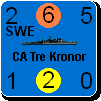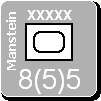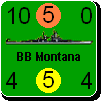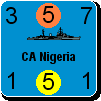Shannon V. OKeets
Posts: 22095
Joined: 5/19/2005
From: Honolulu, Hawaii
Status: offline

|
Mziln culled out all the optional rule text from RAW and I have been editing it for use in MWIF. I see this as most important for players who are new to WIF and need to understand what the optional rules are all about. Specifically, explaining the optional rules might need to be done when a player is starting his very first game of MWIF. So I am taking some care to improve on the text from RAW.
The text will be used in several places: start of game screen, as help, as part of the tutorials, and in the player's manual. Write once, use 4 times sounds good to me.
So here are the first 6 I have done. As I do the others I will post them too for your inspection. At this point I am still finding my 'voice' - by which I mean the tone/writing style. So let me know what you think.
One concern is that editing the text from RAW might distort the rule. I do not want to do that, but I am not super-worried about it. After all, the program will enforce the rules. The purpose of these writeups is to communicate clearly and accurately; however, they do not have to withstand the onslaughts of rules lawyers.
=============================================================
[1][Artillery][RAW 3 s. 22.4.2]
This optional rule adds artillery units to the game. World in Flames uses the word artillery to encompass 3 types of units: Anti-tank guns (AT), Anti-aircraft guns (AA), and Field artillery (ART). As you might expect, the AT units are effective against tanks; the AA units are used against aircraft that are flying missions in the AA unit's hex (or adjacent hexes), and the ART units have the ability to attack adjacent hexes without actually moving into them. All of these unit types are divisions and have the same stacking capabilities of other divisions.
It is best to place AT units in defensive positions that are likely to be attacked by tanks, though some of them are also effective attacking tanks. In particular, AT guns reduce the ability of enemy armor and mechanized units from gaining odds shifts on the combat results table.
AA guns are primarily used to defend a hex and all the hexes that surround it from attack by enemy aircraft. They are commonly used to defend factories, ships in port, and HQ units, though there are numerous other places where a player will have a need to defend against enemy planes.
ART is especially effective attacking fortified units, since it ignores the general defensive benefits of fortifications. Another major use of ART units is to have them bombard (aka, ground strike) enemy units in preparation for an attack or to forestall an impending attack. In this role they are even more effective than air units because they can be used regardless of the weather, do not have to face enemy fighters and AA units, and do not draw down against the limited number of air missions available to a player during an impulse.
When this optional rule is used, there is a new gearing limit class, Artillery, which includes all three of the above unit types. They form three new force pools and, like other units, are sub-divided on the basis of cost.
For movement purposes, AT and ART units may be towed, motorized, or self-propelled. AA units are either towed or motorized. One benefit of self-propelled artillery is that it can make breakthrough moves when advancing after combat, though they are not considered ARM units for any other purpose. Motorized types may also make breakthrough moves but only if they start and end the advance stacked with the same ARM, HQ-A or MECH unit.
In general, a towed or motorized artillery unit has a combat factor (before modification) of 1 when it is not stacked with a non-artillery unit. Two exceptions to the previous sentence are: AA units firing anti-aircraft fire, and bombardment combat by ART units. In both cases, these units have their full strength available for those combats even when they are alone in a hex. All passive artillery units have a combat factor (before modification) of 1, if they are also out of supply.
Anti-tank units
If an AT unit has a combat factor circled in red (rather than pink), double its combat factors when it is attacking a hex containing an enemy ARM, HQ-A or MECH unit. If an AT unit has a combat factor circled in red or pink, double its combat factors when it is defending against an enemy ARM, HQ-A or MECH unit. Each defending anti-tank unit counts as an ARM corps for choice of land combat tables.
Field artillery units
An ART unit can attack exactly like any other land unit. However, an active, in-supply ART unit has a bombardment ability which it can use instead. To indicate this capability, its combat factors are circled in gray. Bombardment does not count against any Activity limits.
An ART unit bombards an adjacent hex as if its printed combat factor were an aircraft's tactical factor. So, it executes a ground strike or a ground support (offensive or defensive) mission into the hex. ART units gain the benefits of Surprise and Offensive chits, when those combat elements are in effect. Their factors are affected by terrain and weather exactly like an
aircraft's tactical factors. An ART unit cannot use its combat factors to bombard if its own hex is being attacked.
If you use an ART unit's combat factors to bombard, its factors are not reduced to '1' due to it being the only land unit in the hex. ART units that bombard across all-sea, river, canal, fortification or straits hex sides do not halve or third their factors. If they take part in normal combat, they are halved or thirded as usual by such terrain. They can't bombard across alpine
hex sides.
An ART unit that bombards becomes passive after the Advance After Combat subphase ends, regardless of the combat result. An ART that bombards (rather than attacking normally) cannot advance after combat. The German railway gun is a towed ART unit. However, it can only move along rail lines (by normal or rail moves) unless being transported. When moving by rail it may move as if it were an HQ.
Anti-aircraft units
If an AA unit has a combat factor circled in red, double its combat factors when it is attacking a hex containing an enemy ARM, HQ-A or MECH unit. If an AA unit has a combat factor circled in red or pink, double its combat factors when it is defending against an enemy ARM, HQ-A or MECH unit. Each defending AA unit which has a combat factor circled in pink or red, counts as an ARM corps for choice of land combat tables.
Active, in-supply AA units can shoot at enemy aircraft flying a mission to the AA unit's hex or to any adjacent hex (this represents the AA unit being spread over a wider area). Each AA unit can fire up to 4 times a step. It can fire 4 times at one hex, three times at one hex and once at another, etcetera. If it fires twice at one hex, double the unit's AA value. If it fires 3 times at
a hex, triple the unit's AA value. If it fires 4 times at a hex, quadruple the unit's AA value. You can add several AA units' values together.
For example, a 3-factor AA unit can fire twice at one hex and twice at another. A 1-factor unit can fire once at the first hex and three times at the second. In total, they fire 7 AA factors at the first hex and 9 at the second.
AA factors fired by light AA units at a hex containing only bombers that took 4 or more turns to produce are halved. Anti-aircraft fire is resolved after air-to-air combat and before the cleared through bombers attack their target. Anti-aircraft fire is resolved against the cleared through bombers (only), reducing tactical, strategic, or air-to-sea factors as appropriate. When defending against a port attack mission, the AA units' factors are added to those of any ships in the port. Anti-aircraft fire is affected by surprise.
If night and day missions are being flown to the same hex, they are treated as separate hexes for anti-aircraft fire.
Anti-aircraft fire is a subphase within almost all air missions: port attacks, strategic bombardment, carpet bombing, ground strike, air transport, paradrops, ground support, and air resupply. If an AA unit uses anti-aircraft fire, its status changes to passive at the end of the subphase. If firing against aircraft providing ground support, the AA unit only becomes passive after the Advance After Combat subphase ends.
==============================================================
[2][Fortifications][RAW 5 s. 22.4.9]
This optional rule permits new fortifications to be built. Fortifications are stationary and either start the game already on the map or can be built by players like any other units. This optional rule controls whether players can build fortifications during the game. It has no effect on preexisting fortifications. That is, the preexisting fortifications are always included in MWIF. Preexisting fortifications are: the Maginot line in France and the defenses around the ports of Sevastopol and Singapore.
When building new fortifications, they are treated as a separate gearing limit class. Any new fortifications (NF) built during a game, including those that are available to the player as part of setup, are similar to the preexisting fortifications (PF), except that they are weaker. In a nutshell, PF cause the strength of attacking units to be reduced to 1/3, while NF cause them to be reduced to ½.
Fortifications cannot move. In and of themselves, fortifications do not prevent enemy units from entering a hex. Indeed, they are destroyed as soon as an enemy land unit enters their hex (both PF and NF). You can voluntarily remove your fortification units from the map in any production step, though why you would do that is not clear.
Note that fortifications have no intrinsic combat value and cannot attack. Happily though for their owners, their combat benefits are not affected by being out of supply. Also, ground strikes and artillery bombardment have no effect on them. Importantly, they cannot be used to satisfy losses in combat. They just have one feature: they reduce the strength of units that attack across the hexsides they are defending.
Fortifications in a hex are oriented towards individual hexsides. For example, the city of Metz in the Maginot line has 2 hexsides protected by fortifications (NW and NE). Next to Metz, the city of Strasbourg has 4 hexsides protected (NW, NE, east, and SE). When new fortifications are placed on the map as reinforcements, the owner must specify which hexside(s) the fortification is protecting. Each fortification that is built can defend 1 hexside. As is obvious from the preceding examples, multiple fortifications can occupy a single hex.
Placement of fortification reinforcements can be in any hex controlled by their owning major power that isn't in an enemy ZOC. Once placed, the orientation of fortifications can not be changed. Only one fortification can be built per hexside. In particular, temporary fortifications can be built in the same hex as permanent fortifications but only to protect hexsides that are not already fortified. It is possible (i.e., legal) to fortify all 6 hexsides of a hex.
Land Combat Effects of Fortifications
Land units attacking across fortified hexsides into the hex that contains the fortifications have their combat value reduced to 1/3 for preexisting fortifications, and to ½ for new fortifications. This is in addition to any other modifiers. However, a unit that paradrops into a hex containing fortifications is not affected by the fortification, since it is not attacking through any hexside. If every land unit attacking a fortified hex attacks through a fortified hexside, then the defender has the choice of combat table.
There is no effect when you attack out of a fort hex.
All fortifications in a hex are destroyed permanently when control of the hex changes.
Example: a German MECH, MOT and INF are attacking a French INF across both the Maginot line and the Rhine River. Therefore, their total combat factors are divided by 6. If they have a total of 23 combat factors, it is reduced to 3.87. A PARA unit dropping into the hex would add its full strength, 4 factors, for a total attack strength of 7.87.
=============================================================
[3][Supply Units][RAW 6 s. 22.4.10]
This optional rule adds supply units to the game. Supply units enable a HQ to serve as a primary supply source for 1 game turn. In order for a supply unit to perform this function, it must be active and in the same hex as an HQ with which it cooperates. If it meets those conditions, then at any time during a game turn (even during an opponent's phase), it can be used to transform the HQ with which it is stacked into a primary supply source. Doing this consumes the supply unit and it is removed from the map. If you are using the optional rule Oil, then as part of the attributes of serving as a primary supply source, the HQ may reorganize oil dependent units (even itself) as if it were 1 oil resource.
Supply units move like a motorized unit but do not change control of hexes they enter. They have no ZOC. They stack as if they were a division (this is true even when the optional rule Divisions is not being used). They can use rail movement. For purposes of naval transport, a TRS can carry 1 supply unit. For purposes of air transport, a supply unit requires 2 ATRs for the air transport mission. An air transport mission of a supply unit can be completed (i.e., the supply unit lands at its destination) if at least 1 ATR survives.
Supply units have no combat value and can not attack. Since supply units can not take part in an attack, they can not advance after combat. They are never affected by combat results (e.g., they do retreat and cannot be used to take casualties).
Land units can enter a hex containing only an enemy supply unit without having to overrun it. The player can then either destroy the supply unit or replace it with one of his own (chosen randomly, since the movement points for supply units may differ).
Supply units are always in supply. Note well, they do not have to trace supply. Passive supply units can be reorganized like any other unit, though if you are using the optional rule Oil, they require oil to be reorganized, just the same as any other unit.
Supply units are a new gearing limit class and cost 3 build points. They may only be built if all the resources used in producing those 3 build points were oil.
=============================================================
[4][Engineers][RAW 7 s. 22.4.1]
This optional rule adds engineer units to the game. Every engineer unit (ENG) is a division sized unit and has capabilities that affect: air unit stacking, factory, oil resource, and major port repairs, and combat. Some engineer units are motorized and receive the benefits of being motorized. Others are marked as MAR units and have the same special abilities as MAR units.
Stacking
Each ENG (even when passive) increases the aircraft-stacking limit of a hex by 1 (e.g. you could stack 2 aircraft in a swamp occupied by 2 ENG units). However, engineers have no effect on the stacking limits for flying boats.
Repairs
When this optional rule is being used, occupied or conquered red factories can not be used until they are repaired. Also, major ports that are occupied or conquered function as minor ports until they are repaired. Major ports are repaired when, during a production phase, an ENG occupies the port hex. The ENG can be either active or passive at the time. Damaged red factories and any destroyed oil resource can be repaired in the same manner, during a production phase, but build points must also be spent to effect the repair.
Combat
When attacking or overrunning across a river, canal or fort hex-side, ENGs are not reduced to a half or a third. They also provide this benefit to land units with which they are stacked, but only as many as the ENG unit's combat value. For example, an ENG with a combat strength of 1 can help only 1 additional unit. ENG attacking across both a river and a fort hexside, ignore only the fort hexside. The defender still has all other non-fort combat benefits when behind a fort hexside.
Engineers provide +1 to the land combat die roll when attacking a city that contains 2 or 3 factories. Engineers subtract 1 from the die roll when defending in a city containing 2 or 3 factories. These benefits are in addition to other benefits and can be used simultaneously (e.g. gaining both benefits when attacking across a river into a 2 factory city). If an ENG provides any benefits in an attack, it always suffers the first loss (even before white print units attacking in winter).
=============================================================
[5][Flying Boats][RAW 7 s. 2.3.1]
This optional rule adds flying boats to the game. Flying boats have pontoons that enable them to land and take off from water. For that reason, they have the benefit, and disadvantage, of being based in coastal hexes. The coast may be alongside an ocean, sea, or lake. Air units that are flying boats can be identified by the blue circle around their air-to-sea combat factor.
Flying boats can only stack in a coastal hex (even if the coast is only on a lake). You can only stack 1 flying boat in a hex, but this is in addition to any other aircraft in the hex. For example, you could stack a flying boat plus 3 other aircraft in a major port; you can even stack a flying boat in a coastal mountain hex.
Flying boats can fly missions into, or rail move through, non-coastal hexes. Engineers have no effect on stacking limits for flying boats. ATR flying boats (e.g. the BV-222) can only air transport units to or from, or air resupply units in, coastal hexes.
Flying boats have one unique vulnerability. If they are based in a coastal lake hex and the lake freezes due to a change in the weather, the flying boat unit is destroyed!
==============================================================
[6][Territorials][RAW 10 s. 22.4.5]
When this optional rule is used, territorial units are added to the game. Territorials are special infantry units. For example, they count against infantry gearing limits. However, they form a new force pool, separate from other infantry unit force pools. You will find that territorial units are typically weaker and slower than regular infantry, but have movement benefits when operating in their home country. One advantage of territorial units is that they are cheaper to build. They also arrive in their home countries which can be a good thing if that country is in the front line, or a bad thing if it is far from any combat zone.
For movement purposes, territorial units treat mountain, forest and jungle terrain in their home country as clear. They pay normal movement costs outside their home country. In addition to other restrictions on minor country units leaving their home country, territorials may only leave their home country if an active Major Power controls them.
In land combat, subtract 1 from the die roll if only Territorials land units are attacking. Similarly, add 1 to the die roll in any land combat if the only land units defending are territorials. This in addition to any modifier for passive units.
Territorials may be built even before you are allowed to reinforce their Minor Country (e.g. USA entry option 41: US reinforces the Philippines). However, Italy can only build the Italian AOI territorial if it controls Ethiopia, Italian Somaliland, or Eritrea.
The Italian AOI territorial can arrive as a reinforcement in any of these 3 countries and it can cooperate with all other Italian territorials. Note that territorials arrive as reinforcements in their home country, not their controlling Minor Country. For example, the NEI territorial arrives in the Netherlands East Indies, not the Netherlands.
The Major Power that controls the territorial’s home country or territory when they arrive as reinforcements controls the territorials. This occurs even if a different Major Power built them. As reinforcements, territorials are placed in any city or port in that territory.
All on map territorials are returned to the force pools when their home country or territory is conquered.
_____________________________
Steve
Perfection is an elusive goal.
|
 Printable Version
Printable Version










 New Messages
New Messages No New Messages
No New Messages Hot Topic w/ New Messages
Hot Topic w/ New Messages Hot Topic w/o New Messages
Hot Topic w/o New Messages Locked w/ New Messages
Locked w/ New Messages Locked w/o New Messages
Locked w/o New Messages Post New Thread
Post New Thread